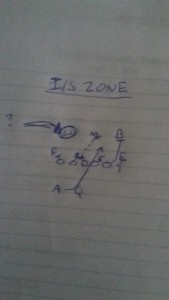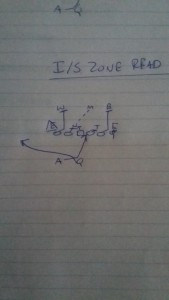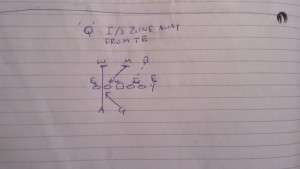Introduction
Paxton Lynch, almost becoming a Dallas Cowboy after Jerry Jones refused to relinquish his third, was the third most coveted QB in the draft behind Carson Wentz and Jared Goff. Paxton Lynch is known around the league before the draft as an unrefined product with a lot of potential, one of the nicest guys you will ever talk to, and a an athlete who struggles in interviews with a blackboard in the back. What cannot be denied though is his tremendous arm talent coupled with his athleticism which will make him special in the NFL if he does get there.
Arm Talent
If you want to talk about a guy that can whip it, Paxton Lynch has that talent and it his nothing less than his calling card. His top-ranked 59 mph throwing speed recorded at the combine is one of many pieces of evidence of that. He also demonstrates ability to throw some incredible touch passes that flash abilities of an elite passer that he can certainly ascertain to. Which means that he has the potential to become a complete passer in the NFL which means he could be one of the few QBs you can rely on to throw 40 times some games and win consistently. That’s something to be excited about in his development.
The route of choice for coaches to see if their QB can throw a Type 1 Pass, or a throw to get the ball from A to B as fast as possible via straight line, is the 15 yard Out. If the QB can get to the top of his drop, fire the ball out of his break, and hit him in stride before the WR touches the sideline, the QB has the ability to consistently make throws like the one above at the professional level.
As you can see, Paxton takes the snap and fakes the tight-read off of I/S (Inside) Zone and gets to the drop of his drop in incredible 9 man protection. He only has one route to throw to, the “Indy” Route, or a pattern that has default adjustments versus one-on-one matchups depending on the CB’s alignment aka. Leverage. So, if the CB is lined up on the I/S shade of the WR, or with I/S leverage, the WR will run a route that sells an inside break and breaks out. If the CB is lined up on the O/S shade of the WR, or with O/S leverage, the WR runs a route that sells an outside break and breaks in. The actual routes are predetermined by the coaching staff at the beginning of the season and are practiced throughout so the QB and WR get on the same page.
Paxton drives with his front foot pointed slightly outside the target. He drives his shoulders through the ball and flicks his hand down to get a tight spiral on the ball. He then finishes through by placing his hand near his “pocket” of his pants to complete the follow-through of the floor. Just like normal QBs. The speed at how he does it though is quite different. He can whip his front shoulder down to create a violent action behind the ball. The rotating motion generates a lot of velocity and the ball travels around 40 yards on a 15 yard route and no defender can get nearby to break it up. The receiver did a nice job of creating separation out of his break. The important note to make on this play though is Paxton can generate some serious velocity on the football. Which is very uncommon for QBs to have because not a lot of QBs can throw as hard as he can. They don’t rotate violently like that, they don’t have the same whip that he has when he is trying to get the ball where he needs to go. His whole body is involved in the throw. Take Dak Prescott for example:
His whole body is not involved in the throw. He has an upper body snap when he throws the ball. You can see the flick of the wrist but his momentum stops when he finished his throw. Efficient and mechanically sound, of course. But not as powerful and violent as Paxton Lynch is. Dak Prescott has a good “snap”, Paxton has a great “whip”.
This is a great skill to have, because he can beat perimeter defenders with his arm and defenders have to cover the whole field. This also adds an element to the quick passing game where he can throw the ball in rhythm with velocity, into WRs running short routes without giving the chance for a defender to jump the route. In addition, If Paxton sees an opening in between any of the LB’s, his ball speed can make up for anticipation as long as he sees the window. And if he needs to get the ball on the O/S shoulder of the WR coming back on a “comeback”, he can deliver the ball fast without putting the ball at risk to get intercepted. That’s what arm speed can do:
After the Type 1 Throw, there is the Type 2 Throw, or what is known as “touch” passes. When the ball needs lift under it to put it over defender’s heads into the WR’s lap, but you keep it down enough so it doesn’t sail over the receiver’s head into a safety’s hands. When Broncos fans like yourselves saw Peyton Manning throw those passes to crossing routes in the middle of the field or Digs (think 15-and-in) and the ball would land softly right on the numbers of the receiver, those were the touch passes I am talking about. In this regard, Paxton Lynch can throw these passes.
Something to also keep in mind: Paxton Lynch threw this on the run off the heel of his back foot. So not only can does he show the ability to throw touch passes, he shows the ability to do it off an awkward platform while also moving laterally. This is not the kind of passing ability you see often coming out of college. This kind of throwing must be learned, trained, drilled, and perfected. Paxton has shown the ability to do it, now he must translate that part of his game to the next level.
This is also a great sign for the Broncos because in in the type of offense that they want to run, they want a “constraint”, a concept that can take advantage of the defense over-committing to the run. One way to get LB’s to suck into the OL is to pull a guard. The Broncos don’t do much of that. But, the next best way to get LB’s to pull up is run the ball effective enough so they have to account for it. When they do, the coaches can run a concept where a WR is running behind the LB’s and the QB can throw it over the top. These are most commonly known as “Deep Crosses”, and they are a staple in the offense that the Broncos want to run. If the defense wants to over commit, Paxton has shown the ability to throw those Type 2’s needed which will create explosive opportunities for the Broncos.
He also does this throwing to the corner which is also prevalent in the Broncos offense when movement passes, or more commonly known as bootlegs, are introduced into the offense:
Paxton Lynch also has the ability to back shoulder passes to their intended targets. These throws need to be made when the receiver is running a vertical route with an O/S release on the defender, and the defender is riding the I/S hip of the WR with his eyes off the QB. In order to back-shoulder a pass, the QB has throw a softer pass on the back shoulder of the WR so that he can flip his hips, gets his hands out for the ball and make the catch before the defender can turn around. Here, he makes a couple great throws:
And here is what we coaches call a “honey-hole” shot. Which is a throw in between the safety and the corner in the void of a Cover 2 look. He can’t lob it over the top so that the safety can pick it over the WR and you can’t throw a Type 1 through because it can get picked off by a LB. So, he has to softly “toss it” into the hole over the shoulder of the WR.
All of these throws are indicative of his ability to be a complete passer. It should not matter what area of the field you want the ball, where you want the ball to be placed, and what type of speed and trajectory you want. Paxton Lynch can find a way to get it there without letting it end up in a defender’s hands. Only the best passers in the NFL have the ability to do that.
Athleticism
Paxton Lynch first and foremost, shows the type of balance, feet, and strength to stay in the pocket in bad situations while keeping his eyes downfield. He also displays the quickness in his feet to evade rushers taking a wide angle at him and understands when to step up or scramble. If the E is taking a wide angle at him, he steps up in the pocket. If the E is ripping inside of him, he scrambles outside. It is the textbook way to do so and he does this very well. His athleticism is not an impairment to his pocket presence, it is a supplement. Which is also the case for guys like Ben Roethlisberger, Cam Newton, and Russell Wilson.
Speaking of Cam Newton, when shown a picture of Newton on the projector by one former QB coach, Jon Gruden, this discussion followed:
Jon Gruden (JG): You know this QB?
Paxton Lynch (PL): I do.
JG: Why (are) you smiling?
PL: This is my guy.
JG: Look at me. Why is he your guy?
PL: This is who I compare myself to. This is who I see myself as.
If you are looking for a QB to compare him to, don’t look any further because he already did. He wants to be a improviser, a strong arm guy that counts as another runner in the backfield. So far, he can do a little of what Cam does with the ball in his hands without the ability to run guys over.
Paxton Lynch has a deceptive fourth gear when he gets out into open space. You don’t see it when he is running through the middle on designed QB Powers scrambles for yards. However, when he breaks the edge of contain of the defense, he can speed up his feet and as a result, can pull away from slower LB’s who lose their pursuit angle on him. He may not be fast, but he can cover ground quick: (On a seperate note, when I become a coach, I want my receivers to block like his did)
When he does hit his fourth gear and he wants to hit the hole, Paxton lowers his pads. Because of his 6’7″ 240 lb frame in addition with his ability to cover ground, Paxton can generate lots of Newtons behind his pads, forcing defenders to take him low.
On this “Flash”, or what is known as a read play off a fly sweep, Paxton reads the end to determine whether to hand the ball off. If the read widens outside of the hole, Lynch will keep it. If the E stays in the hole and gives up contain, Lynch will hand the ball off and sell the fake downhill. Play occurs, the read player widens, and Paxton Lynch keeps the ball for an explosive run.
On the very next play (see above), the Tigers ran a RPO (Run-Pass Option) and the TE ran a “Pop”, or a short seam, to which Paxton popped it over the top of the LB for another big gain. Later in the game, he reads off of a chasing defender and keeps the ball. He gets to the 2nd level and makes a LB miss, gaining yet another explosive run:
Defenders have to honor Paxton’s athleticism. Just like they have to honor Cam’s athleticism. They are concerns with the ball in their hands. Defenses have to account for that runner somehow and when they do, both of these guys can hurt you with their arm.
In the Broncos offense, this type of athlete brings a type of offensive threat that wasn’t present last year. The Broncos can set up their outside zone with a movement pass. They can set up an inside zone off of a play-pass/play-action. More importantly, they can solve their biggest problem running out of their base 11 personnel sets (one RB, one TE, three WR) in that they can now run effectively vs a 7 man box.
What do I mean by that? Welcome to Read-Option 101!
Lets take a look at a standard one-back I/S Zone to the TE. This is called 12-13 Zorro is most playbooks. Against a nickel look with six in the box, the play works great because you can get a hat (blocker) for every defender that is in the box. But, if you have 7 in the box like a standard Over, Under, or Odd front would, you can’t account for the B/S defender whether it would be the Will or the B/S End.

Now, if you were to read the B/S defender and have the T work his way up to block the Will, now you have every defender accounted for in the 7 man box. Which means that the defense now has to dedicate their 7th in the box on the QB.

On top of this, the Broncos now can install a new goal-line package to make short yardage a lot easier than it was in the past. Because you have a QB that can run like Paxton does and shove his nose in there, you can add another hat into the box.
But Dubs, how do you get another player to block when you can only have 11 players on the field?
Great question. Think of it this way: On any given run play, the QB hands the ball off and gets out of the way by faking the pass. Therefore, in order to hand the ball off, the QB can’t block for the RB. Good idea, considering QBs aren’t normally supposed to get hit. But now, if you snap it to the QB and you have the RB block for him:

Now everyone is blocked and the QB can be the A (RB) while the A will be the F (FB) and go block a backer and now with the addition of another body makes for a great goal-line run.
The Broncos, with the addition of Lynch can now run this style of play if they want to. The only other team that has the personnel at QB to do so are the Carolina Panthers with Cam Newton.
The athleticism that Paxton Lynch does have will open up options in the running game while also helping out in the passing game by making the defense decidedly choose whether to fit their gap or retreat to their drops. They have to make a choice and if they guess wrong, as the Broncos play-pass game is good at doing when it can run the ball effectively, there is a vertical shot plus a crossing route uncovered that can go for big yards. They can make play-pass, play-action, movement passes, and QB runs their world if they want to. And I have yet to think Kubiak will not pull the trigger on that opportunity.
On Thursday, I will write some concerns I have for him as well as a factor I think will be important to the state of the team next year.